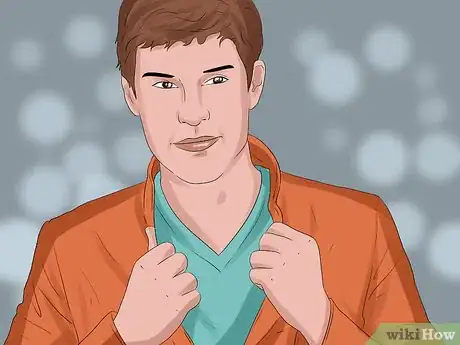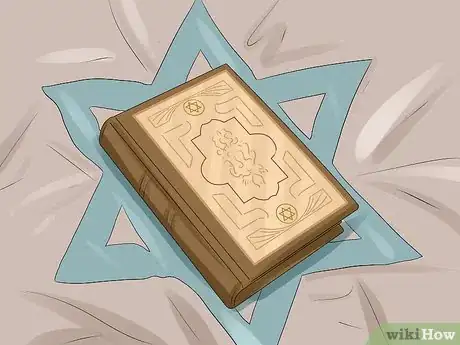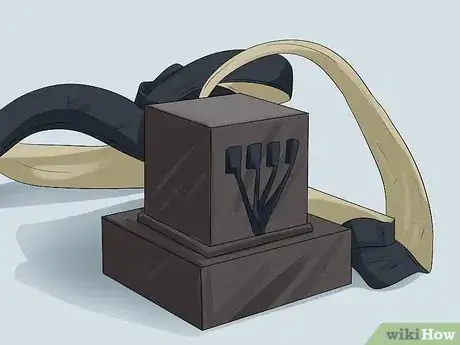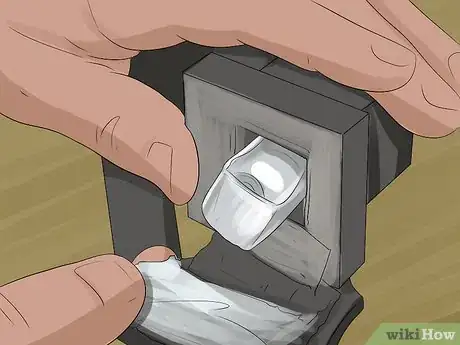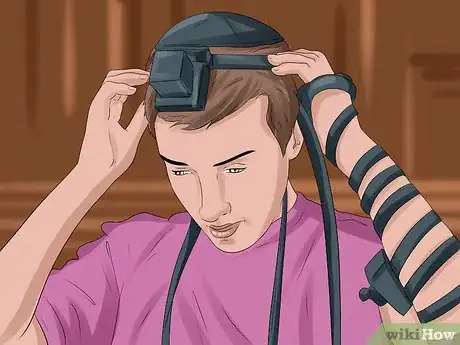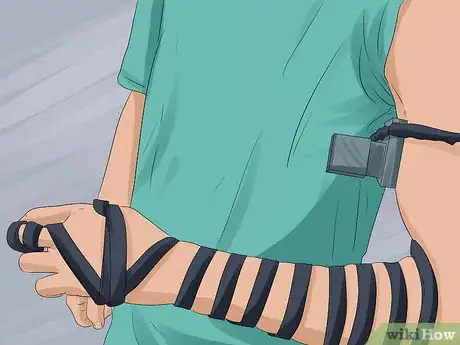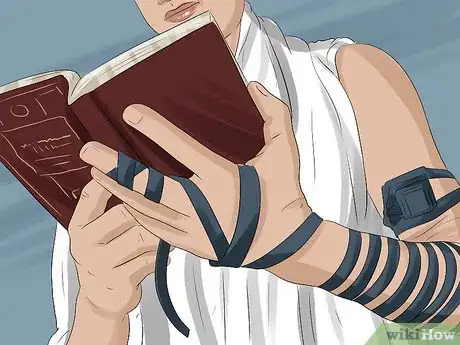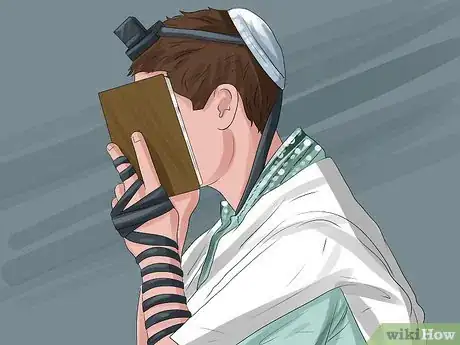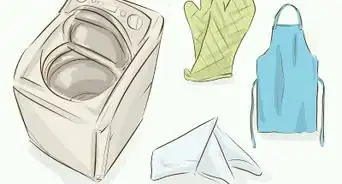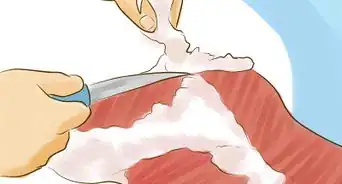X
wikiHow is a “wiki,” similar to Wikipedia, which means that many of our articles are co-written by multiple authors. To create this article, 11 people, some anonymous, worked to edit and improve it over time.
This article has been viewed 23,540 times.
Learn more...
As a male Orthodox Jew, you are required to pray to God three times a day, morning, afternoon, and evening. You are also required to wear a skullcap, tefillin ("Hebrew: "phylacteries") and tallit (Hebrew: "prayer shawl").
Steps
-
1Wear appropriate clothing. Wearing proper clothes during prayer is very important. You are preparing to talk to the King of Kings, and you should be dressed appropriately. Proper clothes include, but are not limited to
- Dress coat
- Dress pants
- Dress shirt
- Regular shoes - NO clogs or sandals. Sneakers are acceptable if you're outdoors.
-
2Make sure that you have the proper Jewish objects. Certain prayer objects are a necessity for the morning prayers. These objects can be purchased online or at your local Judaica store:
- A Jewish prayer book.
- Skullcap
- Prayer shawl
Advertisement -
3Tefillin
- Most prayers take place in synagogues. In general, the minimum amount of men that you should pray together with is 10. However, there are situations where one can pray by themselves. These include sickness, travel, and time availability.
-
4Choose the appropriate time. The three prayers per day correspond to the three periods of the day, as mentioned before. For the morning prayers, the appropriate time is between sunrise and mid-day. It is best to pray before 9:00 AM.
-
5Perform pre-prayer rituals One should wash his hands before prayer. This is in order to wash off the spiritual impurity which has accumulated on your hands while you were asleep. There is a specific way to do so:
- Start with pouring water from a cup on your right hand. The water must cover all of your hand all the way to your wrist. You may need rotate your wrist in order to make sure that your entire hand is washed
- Do the same thing for your left hand ·
- Repeat until you have washed each hand three or four times apiece, depending on your custom. This step only applies to you if you are married, or if your family has the custom to wear a tallit. If you do are not wearing a tallit, proceed to step 7.
- Start by unfolding your tallit. The part of the tallit that has a section of collar is the top end of the garment
- Put the top of the tallit over your head until the front covers your face and say the proper blessing as found in your prayer book
- Wrap the rest of the tallit over your shoulders, and then wrap all for corners over your left shoulder for the amount of time that it takes to walk approximately 6–8 feet (1.8–2.4 m). This should be around four seconds
- While the tallit is wrapped around your head, it is an appropriate time to ask God for things that you need.
Advertisement
Method 1
Method 1 of 4:
Putting On Your Tefillin Shel Yad, Part 1
-
1Put on your tefillin shel yad (Hebrew: "tefillin of the hand"). To do so:
- Open the case and take out the tefillin. Lengthen the strap by the knot so that you can fit the tefillin around your arm
- After rolling up your sleeve, slide the tefillin up your weaker arm. Your weaker arm is usually considered to be the one that you do not write with. If you write fluently with both hands, consult your rabbi for which hand you should use
- Place the tefillin on your bicep muscle. The tefillin should be on the muscle; if the tefillin is too low or too high on your arm, it is not considered to be worn properly
- Before you tighten the strap, say the blessing for the tefillin shel yad that is found in the Siddur. The tefillin should be adjusted to be facing upwards, leaning slightly inwards, to be closer to the heart.
- Once situated correctly, wrap the strap once more around your upper arm. After that, wrap the strap seven times around your forearm, ending above the wrist
-
2Put On Your Tefillin Shel Rosh (Hebrew: "tefillin of the head") is put on after the tefillin shel yad is started, but not completely finished. To do so:
- Just like for the tefillin shel yad, unwrap the leather straps from around the casing
- Put the tefillin on top of your head, with the ‘box’ sitting in front and the knot on the back of your head. The "box" should be situated between your eyes, and the knot should be centered in the back of your head. Most people use a mirror to make sure that the box is centered
- At this point, say the blessing for the tefillin shel yad which is found in the prayer book.
- Make sure that the straps coming out of the knot are in the front of your body. One should be on the left side, and the other should be on the right
- The tefillin box should be no higher than the middle of your head, and no lower than your hairline. If it is, the tefillin is not considered to be worn properly
Advertisement
Method 4
Method 4 of 4:
Post-Prayer
-
1After prayer is over wrap up your tefillin and tallis. There is a specific order to taking off your tefillin
- Unwrap the strap off of your hand
- Take your tefillin shel rosh off of your head. You should bow your head as you take it off, in order to appear to be sad to be taking off a holy object
- Carefully put the tefillin shel rosh into the tefillin case. Wrap the straps around the box and put the tefillin back in the "box."
- Unwrap the rest of the tefillin shel yad from your forearm, and slide it off of your arm. Carefully put the tefillin back in its casing, and wrap the strap around the casing.
- Place the tefillin back into the tefillin "box" along with the Tefillin Shel Rosh
-
2Take off your tallit and fold it the best that you can. There is no set way to fold a tallit. Make sure to pack your prayer book as well
-
3Enjoy the rest of your morning! Now that you have finished praying to God, you are ready to start your day! Even though you are done using your tallit, tefillin, and prayer book, make sure to treat them with respect, as they are holy objects.
Advertisement
Community Q&A
-
QuestionCan I pray without a tefillin?
 aviad goldsteinCommunity AnswerYes, but the obligation for Jews is at least to put in on over the course of the day.
aviad goldsteinCommunity AnswerYes, but the obligation for Jews is at least to put in on over the course of the day.
Advertisement
About This Article
Advertisement
